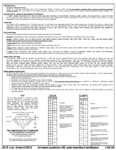Jewelry Appraisal
Each piece of jewelry you purchase should be accompanied by a written appraisal that:
- describes all characteristics of the piece, including weights, grades, and measurements;
- states any treatments given the gem that are not part of the usual processing of this type of gemstone, or states that the gem is untreated;
- states whether the gem is natural or synthetic;
- gives the manufacturer, workmanship, metal and karatage of the mounting;
- gives the value of the jewelry; and
- includes a photograph of the gem.
Such an appraisal will serve as your written assurance of the quality of the jewelry. It will also help your insurer set the proper premiums. And, should you ever need to file a claim, this detailed description insures that your replacement jewelry matches the quality of the piece you originally purchased.
Insurers recommend that their policyholders get jewelry appraisals on JISO/ ACORD appraisal forms. (ACORD is a non-profit organization that sets electronic and print standards for the insurance industry. The jewelry appraisal standards and forms were developed by ACORD and are now supported by JISO, Jewelry Insurance Standards Organization.)
All forms can be printed out at www.jiso.org.
JISO 805 Jewelry Sales Receipt for Insurance Purposes
When you are buying jewelry: This form can be completed by the retailer who sells you the jewelry. Properly filled out, it gives sufficient detail to properly insure your jewelry. It’s a good idea to print out this form and take it along when you shop for jewelry.
JISO 806 Jewelry Document for Insurance Purposes
When you're getting a 2nd appraisal: Any trained jeweler/appraiser can use this form. It provides essential descriptive information needed to insure your jewelry. We recommend the appraiser be a Graduate Gemologist, having the expertise to examine the jewelry and determine its qualities.
JISO 78 Jewelry Insurance Appraisal – Single Item
If your appraiser is a GG and a CIA™: This is a detailed appraisal with reliable information and warrantees that protect the consumer. It guarantees that the jewelry was inspected by the appraiser in a gem lab (rather than just relying on the word of the gem supplier), describes the jewelry in precise gemological language, and uses internationally recognized grading scales. This form must be completed by a CIA™.
JISO 79 Jewelry Insurance Appraisal [for multiple items]
If your appraiser is a GG and a CIA™: Similar to JISO 78, this form is used for multiple items being appraised together. It must be completed by a CIA™
This is an example of an JISO Jewelry Appraisal for a diamond engagement ring.
JISO jewelry appraisal, filled out
(Click for larger image)
Notice how the appraisal specifically describes the mounting, giving the karatage of the metal, trademark, workmanship, size and weight. The gem itself is a round brilliant shape diamond in a 6-prong setting. All the cutting proportions are given, as well as the color and clarity grades and the carat weight.
With this appraisal form, you know all the essential information is included because all the blanks are filled in.
Additional lines in the upper section of the appraisal are for jewelry having multiple stones. Such detailed information would be given for each stone, or grouping of small stones, in the piece.
The "Optional Description" might include any other relevant information, such as if the stone was synthetic or had received any gem treatments, if a ring was engraved, etc.
The lower section is for gems and jewelry requiring other specific information.
The appraisal uses the phrase "estimated replacement value" (rather than simply "value") because this is an insurance appraisal and will be consulted if your jewelry is lost or damaged and needs to be replaced. The amount quoted is a fair estimation of value based on its usual selling price; it is not based on a retailer's claim of the jewelry's "real worth," when he says he is selling it to you at 50% below price.
The paragraph above the appraiser's signature says that the appraisal is being written for both the customer and the insurer. This means the appraiser stands behind his descriptions and valuation, and offers the same warranties to the insurer as to the purchaser.
Reverse side of Appraisal (Click for larger image)
Shopping Considerations and Caveats
- Beware of jewelry appraisals on fancy letterhead — some even look like they're meant to be framed — that leave out crucial information. Such a document, which favors appearance above information, does not serve you.
- Beware of appraisals that have, just above the jeweler's signature, a disclaimer such as "The foregoing appraisal is made and accepted upon the express understanding that NO Liability or Responsibility is incurred by the Appraiser giving same." There are variations in the phrasing, but "no liability" means the appraiser does not take responsibility for the truth of the appraisal. There is no such disclaimer on the JISO/ACORD appraisal.
- After purchasing jewelry (that does not come with a JISO/ACORD appraisal), have it independently appraised to be sure it is of the quality stated by your retailer. Do not go to an appraiser recommended by the seller but to a jeweler/appraiser of your choice. Seek out a jeweler who is a graduate gemologist and has a gem lab on site—preferably a Certified Insurance Appraiser™ .
- Locate a Certified Insurance Appraiser™
 Buyer’s
Tip
Buyer’s
Tip
When purchasing jewelry, be sure you have the option of returning the jewelry
within a limited period of time. This allows you to return the piece if an
independent appraisal shows the jewelry is not of the quality the retailer
claimed. Such a return is immeasurably easier if you make your purchase by
credit card, rather than by cash or check.


